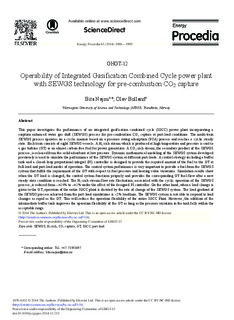| dc.contributor.author | Najmi, Bita | |
| dc.contributor.author | Bolland, Olav | |
| dc.date.accessioned | 2016-02-15T12:15:13Z | |
| dc.date.accessioned | 2016-04-15T12:36:29Z | |
| dc.date.available | 2016-02-15T12:15:13Z | |
| dc.date.available | 2016-04-15T12:36:29Z | |
| dc.date.issued | 2014 | |
| dc.identifier.citation | Energy Procedia 2014, 63:1986-1995 | nb_NO |
| dc.identifier.issn | 1876-6102 | |
| dc.identifier.uri | http://hdl.handle.net/11250/2385812 | |
| dc.description.abstract | This paper investigates the performance of an integrated gasification combined cycle (IGCC) power plant incorporating a sorption enhanced water gas shift (SEWGS) process for pre-combustion CO2 capture at part-load conditions. The multi-train SEWGS process operates on a cyclic manner based on a pressure swing adsorption (PSA) process and reaches a cyclic steady state. Each train consists of eight SEWGS vessels. A H2-rich stream which is produced at high temperature and pressure is sent to a gas turbine (GT) as an almost carbon-free fuel for power generation. A CO2-rich stream, the secondary product of the SEWGS process, is released from the solid adsorbent at low pressure. Dynamic mathematical modeling of the SEWGS system developed previously is used to simulate the performance of the SEWGS system at different part-loads. A control strategy including a buffer tank and a closed-loop proportional integral (PI) controller is designed to provide the required amount of the fuel to the GT at full-load and part-load modes of operation. The control system performance is very important to provide a fuel from the SEWGS system that fulfils the requirement of the GT with respect to fuel pressure and heating value variations. Simulation results show when the GT load is changed, the control system functions properly and provides the corresponding GT fuel flow after a new steady-state condition is reached. The H2-rich stream flow rate fluctuation, associated with the cyclic operation of the SEWGS process, is reduced from ∼ ± 14% to ∼ ± 1% under the effect of the designed PI controller. On the other hand, when a load change is given to the GT, operation of the entire IGCC plant is dictated by the rate of change of the SEWGS system. The load gradient of the SEWGS process achieved from the part-load simulations is ∼2% load/min. The SEWGS system is not able to respond to load changes as rapid as the GT. This will reduce the operation flexibility of the entire IGCC Plant. However, the addition of the intermediate buffer tank improves the operation flexibility of the GT as long as the pressure variation in the tank falls within the acceptable range. | nb_NO |
| dc.language.iso | eng | nb_NO |
| dc.publisher | Elsevier | nb_NO |
| dc.rights.uri | http://creativecommons.org/licenses/by-nc-nd/3.0/ | |
| dc.title | Operability of Integrated Gasification Combined Cycle Power Plant with SEWGS Technology for Pre-combustion CO2 Capture | nb_NO |
| dc.type | Journal article | nb_NO |
| dc.type | Peer reviewed | nb_NO |
| dc.date.updated | 2016-02-15T12:15:13Z | |
| dc.subject.nsi | SEWGS; H2-rich; CO2 capture; GT; IGCC; part-load | nb_NO |
| dc.source.pagenumber | 1986-1995 | nb_NO |
| dc.source.volume | 63 | nb_NO |
| dc.source.journal | Energy Procedia | nb_NO |
| dc.identifier.doi | 10.1016/j.egypro.2014.11.213 | |
| dc.identifier.cristin | 1199642 | |
| dc.description.localcode | © 2013 The Authors. Published by Elsevier Ltd. This is an open access article under the CC BY-NC-ND license http://creativecommons.org/licenses/by-nc-nd/3.0/ | nb_NO |

